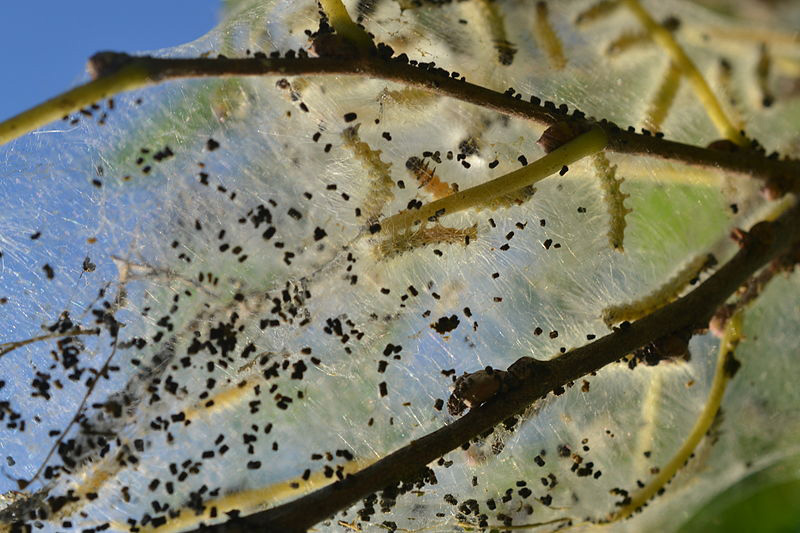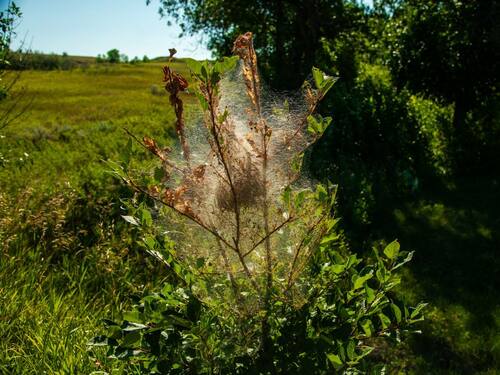Pest of the Month: Fall Webworms
Introduction
Pests can cause significant aesthetic and, in some cases, structural damage to the trees in your yard. Staying informed about common tree pests ensures that you can take swift action to maintain your landscape’s health and beauty.
This month, we’re spotlighting the fall webworm , a pest well known for its distinctive webbed nests on tree branches in late summer and early fall. While primarily an aesthetic concern, many homeowners prefer to keep their trees webworm-free.
Let’s explore what fall webworms are, the damage they cause, and how to control them effectively.
What are Fall Webworms?
Fall webworms are moths in the family Erebidae , best known for their larval stage when they create silky webbed nests on tree branches. These webs can engulf entire sections of trees, making them a conspicuous presence during late summer and fall.

Fall Webworms ( Hyphantria/Cunea/Andrew C/ Rentschler Forest Fairfield OH / Wikipedia Commons
Key Characteristics:
- Adult Appearance: The adult fall webworm is a fluffy white moth with a wingspan of approximately 30mm.
- Egg-Laying Behavior: Female moths lay hundreds of eggs on the undersides of tree leaves. These eggs hatch into larvae, which are responsible for building the large webs.
- Life Cycle: In most northern regions of the United States, fall webworms produce a single generation per year.
Fall webworms primarily infest hardwood trees, including black walnut, pecan, hickory, and persimmon. They are familiar to arborists and tree care professionals, often receiving removal requests from homeowners seeking to restore their trees’ natural appearance.
The Damage Fall Webworms Cause
Are Fall Webworms Harmful to Trees?
For healthy trees, fall webworms are more of a cosmetic issue than a serious threat. However, the webbing they create can detract from the natural beauty of your trees and landscaping.

A Webworm Nest Encasing a Tree Branch in a Sunny Field
Signs of Infestation:
- Unsightly Webbing: Large white fluffy webs engulf tree branches, making trees look unkempt.
- Defoliation: In rare cases, heavy infestations can cause significant defoliation. This is unlikely to kill mature, healthy trees but may weaken younger trees or stressed trees.
Ecological Benefits:
Interestingly, fall webworms play a role in the local ecosystem. Their larvae serve as a food source for over forty species of birds. If you can tolerate their webs, you may indirectly support local wildlife by allowing them to remain.
How to Treat Fall Webworms
If you decide to remove fall webworms from your trees, several methods are effective. Choose a treatment method based on the severity of the infestation and your personal preferences.

Fall Webworm Control: Dormant Oil, Insecticides, and Fire Tips
1. Pruning and Physical Removal
For small infestations, simply prune the affected branches and dispose of the webbing. This method is straightforward, eco-friendly, and effective if the population is limited.
2. Dormant Oil
Dormant oil is a highly effective solution for treating pests, including fall webworms.
- How It Works: Dormant oil suffocates pests by covering their breathing tubes or destroys their protective coating.
- Application Timing: Apply during late winter or early spring when trees are dormant. Avoid using it after trees begin budding, as it may damage new growth.
- Where to Buy: Available online and at local garden supply stores.
3. Insecticides
For larger infestations, you may need to use insecticides. Consider these options:
- Sevin : A widely used insecticide for pest control.
- Malathion : Effective but leaves a residue on tree leaves.
- Orthene : Another reliable choice for controlling webworms.
4. Burning Webs
Although burning webs is effective, it is a high-risk approach and not recommended for safety reasons. Using a propane torch attached to a pole to burn the webs can pose a fire hazard. If you choose this method, exercise extreme caution and follow all safety protocols.
Preventing Fall Webworm Infestations
Proactive Measures:
- Regular Monitoring: Inspect your trees frequently, especially in late summer, to catch infestations early.
- Healthy Trees: Maintain tree health through proper watering, mulching, and fertilization to reduce vulnerability to pests.
- Natural Predators: Encourage birds and beneficial insects like wasps, which help control webworm populations.
By taking preventive steps, you can reduce the likelihood of fall webworm infestations in your landscape.
Final Thoughts on Fall Webworms
Fall webworms are primarily a nuisance pest, affecting the aesthetic appeal of trees rather than their overall health. While tolerating them can benefit local wildlife, many homeowners prefer to remove them to maintain their landscaping’s pristine appearance.
If you’re unsure how to handle an infestation or want professional help, contact Arborist Now . Our experts can assess the situation and provide effective solutions to keep your trees healthy and beautiful year-round.
Originally posted on August 29, 2018
We may receive affiliate compensation for some of the links below at no cost to you if you decide to make a purchase.


